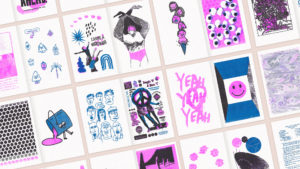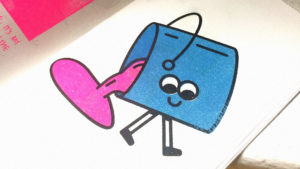Process Spotlight: Risograph Printing
Once in a while you’ve got to get out from behind the computer. Here at athletics we believe that inspiration comes in many shapes and forms, and that getting back to a more tactile design practice can greatly inform the work we do. Plus it’s just fun. This month, Athletics designer Ellen Voorheis shares her exploration into the world of Risograph printing.
History
Risographs are digital duplicators designed for medium volume printing. Known for its silkscreen-like texture and vibrant spot color inks, Risograph printing is an extremely efficient and cost-effective alternative to other printing methods.
A cousin of the more commonly used mimeograph, The Risograph printer was invented by The Riso Kagaku Corporation in 1958 Tokyo. In Japanese, riso translates to “ideal” and kagaku to “science.” Noboru Hayama founded the company in 1946, pursuing a more economic printing method after WWII, when emulsion inks were only available in Japan through an expensive importing process. After about a decade of mimeograph printing and developing emulsion inks, the company launched the first “Riso-Graph” device. It entered American offices and schools in 1986. Since then Riso has released numerous digital duplicators, inkjet printers, and digital screen makers.

Process
Like a mimeograph or spirit duplicator, Risographs use a stencil to make duplicates. The stencil is wrapped around a rotating print drum that pushes ink through the screen and onto the paper. Like screen printing, Risographs lay down just one color at a time, so a three-color print must be fed through the machine three times, replacing the color drum each time. This linear process, along with the slight transparency of the soy-based inks, allows for unique variations in overprinting.
The risograph printing process is inherently imperfect. Ink transfer, roller marks, and misregistration can occur due to the wetness of the ink and the speed of the machine. Much of this can be troubleshot, but unlike a standard inkjet printer, the process on a Risograph involves much more trial and error, micro-adjustments, and often, happy accidents. This unpredictability is one reason Risographs have become such a popular medium for artists.

Resurgence
The popularity of Risograph printers in office settings quickly dwindled in the 90’s. In the last few decades, however, this outdated technology has become a darling of the art and design community. The relatively low price point, vibrant palette of spot colors, unusual print texture, and experimental melding of digital and analog processes make Risographs a popular medium for zines and art prints. Independent publishing houses such as Perfectly Acceptable, Caboose and TXTbooks are fueling a “Riso Renaissance” in the States. Abroad, the Risograph craze has also taken hold, as evidenced by this atlas of modern risography.
At Athletics, Designer Ellen Voorheis recently expanded upon her screen printing background to join the Risograph world, acquiring a Risograph RZ220. As we approached the 6 month mark of working remotely, the team thought it would be fun to create an Athletics zine. Each team member submitted a page, with results ranging from illustration to 3D renders to recipes. The following is the result.


